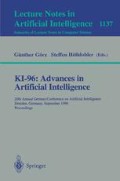Abstract
For a speech understanding graphic editor, a compiler-interpreter-system is introduced to process a semantic structure, a special form for representing the semantic content of a spoken utterance. After a semantic structure has been converted to database queries by the compiler, the interpreter processes all these queries and updates the corresponding database, i.e. in our case the graphics data base containing the features of all objects on the screen. The system has been tested with 1843 semantic structures of spoken utterances within the ’graphic editor’ domain. The rate for correct database queries is 97.3%. Storage of the whole domain-specific knowledge in external and editable files enables easy portability to other domains.
Preview
Unable to display preview. Download preview PDF.
References
A. Aho, R. Sethi, J.D. Ullmann: Compilerbau, Addison Wesley, 1988
L. Goldschlager, A. Lister: Informatik: Eine moderne Einführung, Hanser, 1990
J. Müller, H. Stahl: Die semantische Gliederung als adäquate semantische Repräsentationsebene für einen sprachgesteuerten ‚Grafikeditor', in L. Hitzenberger (ed.): Angewandte Computerlinguistik, „Sprache und Computer“ (No. 15), Georg Olms, 1995, pp. 211–225
J. Müller, H. Stahl: Collecting and Analyzing Spoken Utterances for a Speech Controlled Application, Proc. Eurospeech 1995 (Madrid, Spain), pp. 1437–1440
D. Petkovic: SQL die Datenbanksprache, McGraw-Hill, 1990
R. Pieraccini, E. Levin, E. Vidal: Learning how to Understand Language, Proc. Eurospeech 1993 (Berlin, Germany), pp. 1407–1412
H. Stahl, J. Müller: A Stochastic Grammar for Isolated Representation of Syntactic and Semantic Knowledge, Proc. Eurospeech 1995 (Madrid, Spain), pp. 551–554
H. Stahl, J. Müller, M. Lang: An Efficient Top-Down Parsing Algorithm for Understanding Speech by Using Stochastic Syntactic and Semantic Models, Proc. ICASSP 1996 (Atlanta, USA), pp. 397–400
Author information
Authors and Affiliations
Editor information
Rights and permissions
Copyright information
© 1996 Springer-Verlag Berlin Heidelberg
About this paper
Cite this paper
Ebersberger, M., Müller, J., Stahl, H. (1996). A compiler-interpreter-system for decoding the user's intention within a speech understanding application. In: Görz, G., Hölldobler, S. (eds) KI-96: Advances in Artificial Intelligence. KI 1996. Lecture Notes in Computer Science, vol 1137. Springer, Berlin, Heidelberg. https://doi.org/10.1007/3-540-61708-6_47
Download citation
DOI: https://doi.org/10.1007/3-540-61708-6_47
Published:
Publisher Name: Springer, Berlin, Heidelberg
Print ISBN: 978-3-540-61708-2
Online ISBN: 978-3-540-70669-4
eBook Packages: Springer Book Archive

